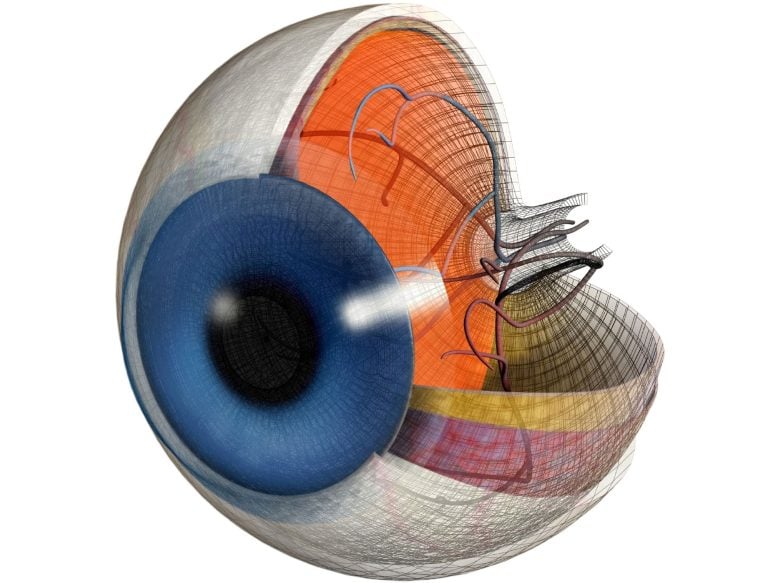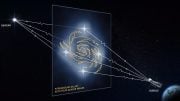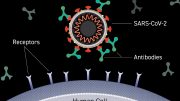
Eye Sectional Anatomy
NEI study in ground squirrels suggests dual function for mitochondria in photoreceptor cells.
Researchers at the National Eye Institute (NEI) have discovered that power-producing organelles in the eye’s photoreceptor cells, called mitochondria, function as microlenses that help channel light to these cells’ outer segments where it’s converted into nerve signals. The discovery in ground squirrels provides a more precise picture of the retina’s optical properties and could help detect eye disease earlier. The findings, published today in Science Advances, also shed light on the evolution of vision. NEI is part of the National Institutes of Health.
“We were surprised by this fascinating phenomenon that mitochondria appear to have a dual purpose: their well-established metabolic role producing energy, as well as this optical effect,” said the study’s lead investigator, Wei Li, Ph.D./B.M., who leads the NEI Retinal Neurophysiology Section.
The findings also address a long-standing mystery about the mammalian retina. Despite evolutionary pressure for light to be translated into signals and pass instantly from the retina to the brain, the trip is hardly direct. Once light reaches the retina, it must pass through multiple neural layers before reaching the outer segment of photoreceptors, where phototransduction (the conversion of light’s physical energy into cellular signals) occurs. Photoreceptors are long, tube-like structures divided into inner and outer segments. The last obstacle a photon must traverse before moving from the inner to the outer segment is an unusually dense bundle of mitochondria.
Mitochondria in cone photoreceptors have a dual purpose: They generate energy for the cell and in a new study they also act as microlenses. This optical role helps concentrate light as it moves from the cell’s inner to outer segment. The outer segment is where the light’s physical energy is translated into cellular signals. Credit: National Eye Institute
Those bundles of mitochondria would seem to work against the process of vision either by scattering light or absorbing it. So, Li’s team set out to investigate their purpose by studying cone photoreceptors from the 13-lined ground squirrel.
Unlike other animal models used for vision research, the 13-lined ground squirrel’s retina comprises mostly cones, which see color, as opposed to rods that enable night vision. Li’s team studies the 13-lined ground squirrel to better understand the causes of human eye diseases that primarily affect cone photoreceptors.
The researchers used a modified confocal microscope to observe the optical properties of living cone mitochondria exposed to light. Far from scattering light, the tightly packed mitochondria concentrated light along a thin, pencil-like trajectory onto the outer segment. Computational modeling using high-resolution mitochondrial reconstructions corroborated the live-imaging findings.
“The lens-like function of mitochondria also may explain the phenomenon known as the Stiles Crawford effect,” said first author of the paper, John Ball, Ph.D., a staff scientist in the Retinal Neurophysiology Section.
Scientists measuring retinal responses to light have long observed that when light enters the eye near the center of the pupil, it appears brighter compared to light of equal intensity entering the eye near the edge of the pupil.
In this study, Li found that the lens-like effect of mitochondria followed a similar directional light intensity profile. That is, depending on light source location, the mitochondria focused light into the outer segment of the cell along trajectories that mirrored those observed from the Stiles-Crawford effect.
Linking mitochondria’s lens-like function to the Stiles-Crawford effect has potential clinical implications. The long-observed effect may now be used as the basis for non-invasively detecting retinal diseases, many of which are thought to involve mitochondrial dysfunction at their origin. For example, patients with retinitis pigmentosa have been reported to have abnormal Stiles-Crawford effect even when they have good visual acuity. More research is needed to explore the structural and functional changes in cone mitochondria and their manifestations in detectable optic features.
Finally, the findings provide new insights into how our eyes may have evolved.
Like the mitochondria in Li’s study, within the photoreceptors of birds and reptiles, tiny oil droplets are located in the portion of the inner segment closest to the outer segment, and they are thought to serve an optical role. Furthermore, the mitochondrial “microlens” in mammalian cone photoreceptors confers a functionality reminiscent of that achieved by the compound eye of arthropods like flies and bumblebees.
“This insight conceptually bridges compound eyes in arthropods with the camera eyes of vertebrates, two independently evolved image-forming systems, demonstrating the power of convergent evolution,” Li said.
Reference: “Mitochondria in cone photoreceptors act as microlenses to enhance photon delivery and confer directional sensitivity to light” by John M. Ball, Shan Chen and Wei Li, 2 March 2022, Science Advances.
DOI: 10.1126/sciadv.abn2070
The study was funded by the NEI Intramural Research Program.









Y’know, interesting as this may be, the moment that I read about how it involved animal testing, my gut turns and something tells me that it’s not worth it to know. There is a cost benefit analysis which factors into every single thing that we do, and the result of this analysis is a pretty clear indication of what we think is “more important.” Mentality is important, and for acts like this, I am ashamed of my species and what we do to other species.
How human.
I have problem in my eye , I hv floaters and light flashes I can’t she in night times to street light or bike light ….any treatment is there for that